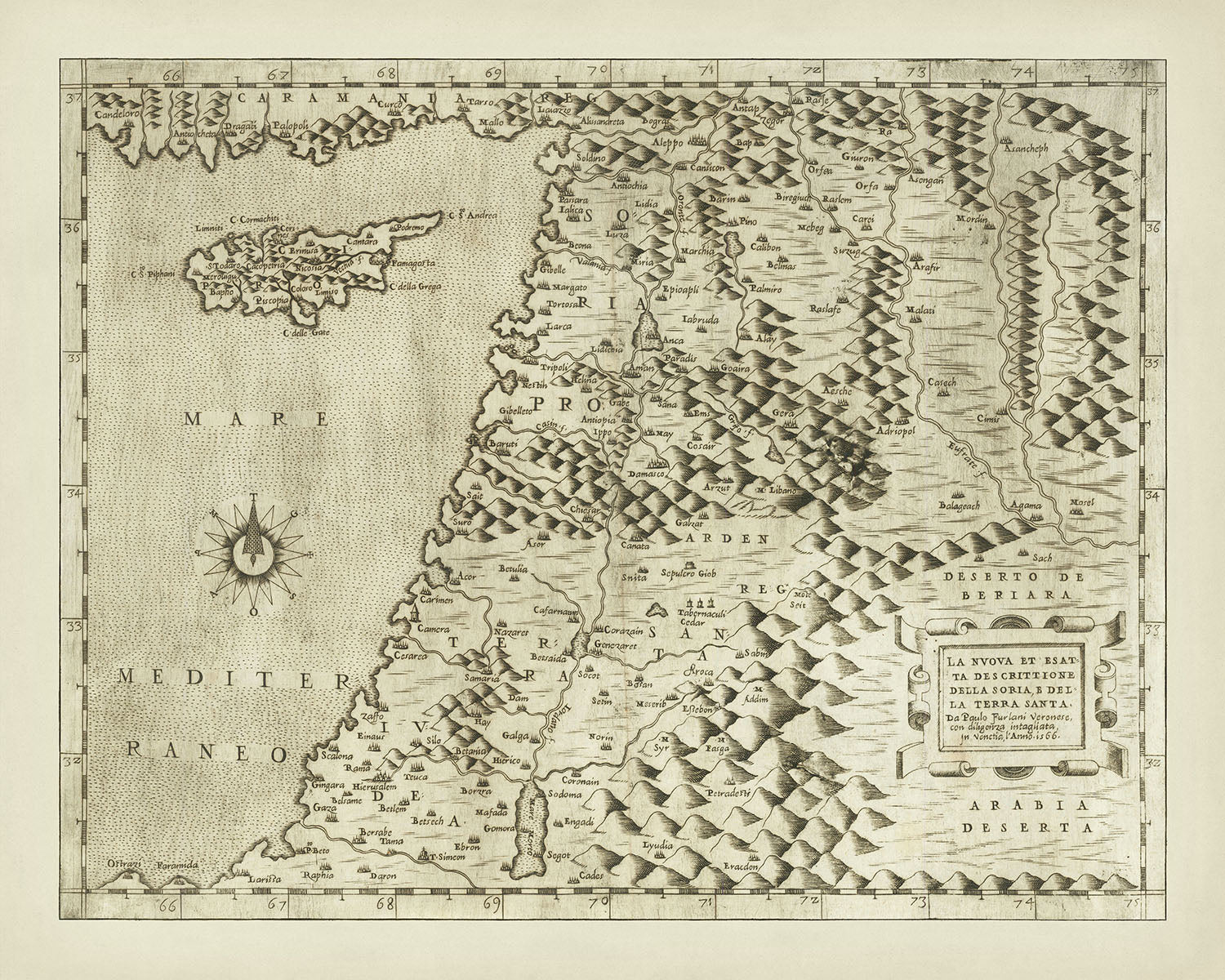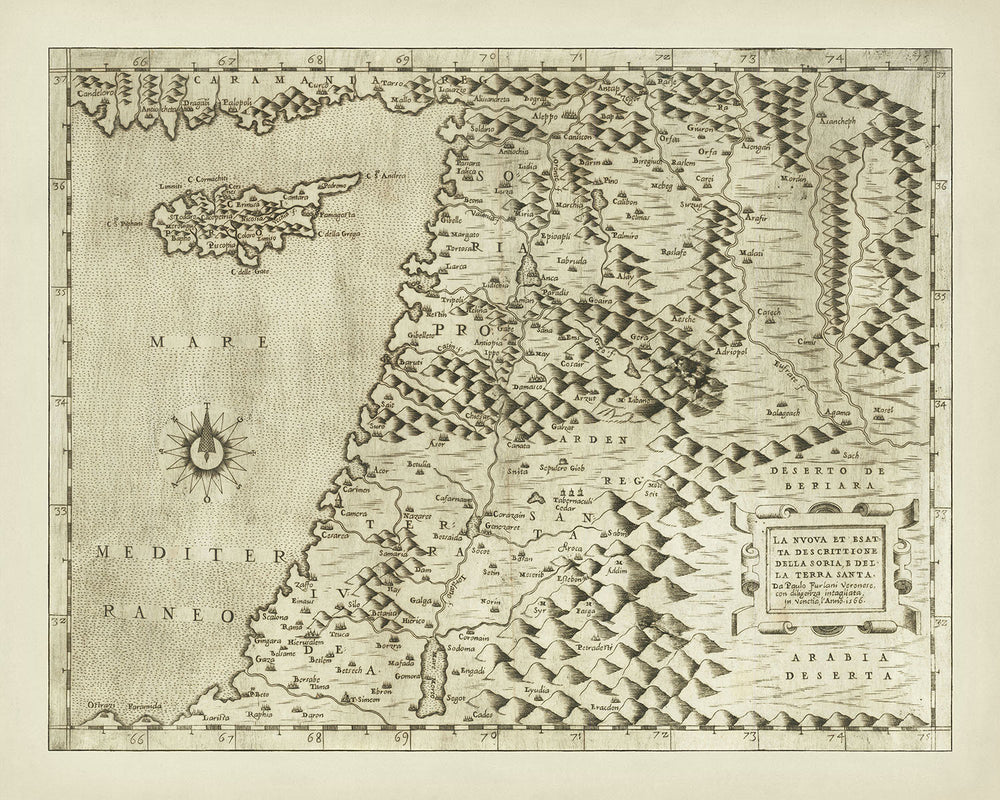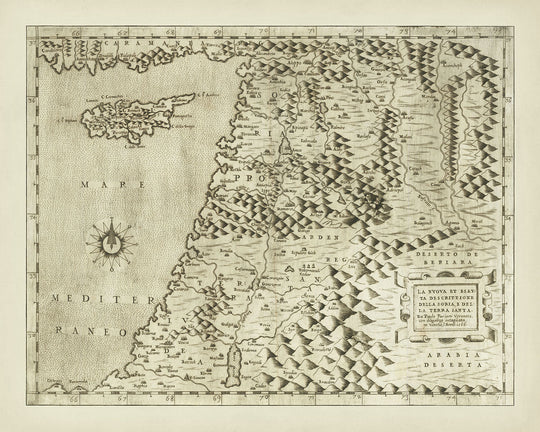- Handmade locally. No import duty or tax
- FREE Delivery by Christmas
- Love it or your money back (90 days)
- Questions? WhatsApp me any time
Own a piece of history
5,000+ 5 star reviews


La Nuova et Esatta Descrittione della Soria, e Della Terra Santa, crafted by the illustrious Paolo Forlani in 1566, is a masterpiece of cartographic art that captures the essence of the Holy Land and Cyprus. This map, a fine example of the Lafreri School's work, stretches from the Dead Sea and Jerusalem in the south to Aleppo in the north, offering a detailed and evocative depiction of a region steeped in history and religious significance. The map's intricate design and rich historical context make it a coveted piece for collectors and historians alike.
Paolo Forlani, a distinguished member of the Lafreri School, was known for his meticulous and decorative cartographic works. The Lafreri School, active in Rome and Venice from the mid-16th century, produced maps that were often bound into composite atlases tailored to the buyer's interests. Forlani's map is based on earlier works by Waldseemüller and Gastaldi, yet it stands out for its larger size and ornate details, reflecting the evolving cartographic techniques and artistic sensibilities of the period.
The map is a visual journey through the Holy Land, featuring notable cities such as Jerusalem, Damascus, and Aleppo, each marked with historical and religious significance. The terrain is depicted with hilly landscapes and numerous rivers, providing a sense of the region's geography. Cyprus, prominently displayed in the Mediterranean, is shown as a mountainous yet densely settled island, highlighting its strategic and economic importance during the era.
Landmarks such as tombs and tabernacles are meticulously marked, underscoring the map's religious and cultural importance. The inclusion of these sites offers a glimpse into the spiritual landscape of the time, making the map not just a geographical tool but also a document of pilgrimage and devotion. The compass rose in the Mediterranean Sea adds a touch of navigational elegance, guiding the viewer through the intricate details of the map.
The historical significance of this map is profound, as it reflects the early modern period's fascination with the Holy Land. Maps of this region were highly sought after, serving both as tools for navigation and as symbols of religious devotion. Forlani's map, with its rarity and exquisite detail, represents a pinnacle of Renaissance cartography, capturing the imagination and reverence of its contemporary audience and continuing to inspire admiration today.
Cities and towns on this map:
- Holy Land:
- Aleppo
- Damascus
- Jerusalem
- Sidon
- Tyre
- Beirut
- Tripoli
- Nazareth
- Bethlehem
- Gaza
- Jaffa
- Acre
- Tiberias
- Hebron
- Ascalon
- Ashdod
- Ariha (Jericho)
- Caesarea
- Safed
- Hama
- Homs
- Aradus
- Bostra
- Petra
- Gadara
- Pella
- Gerasa
- Philadelphia (Amman)
- Raphia
- Antioch
- Laodicea
-
Apamea
-
Cyprus:
- Nicosia
- Limassol
- Famagusta
- Larnaca
- Paphos
- Kyrenia
Notable Features & Landmarks:
- Landmarks:
- Tombs and tabernacles are marked on the map.
- Bodies of water:
- Mediterranean Sea (Mare Mediterraneo)
- Dead Sea
- Mountains:
- The terrain appears hilly with numerous mountain ranges depicted.
- Other notable features:
- Compass rose in the Mediterranean Sea.
Historical and design context:
- Name of the map: La Nuova et Esatta Descrittione della Soria, e Della Terra Santa
- Date created: 1566
- Mapmaker/Publisher: Paolo Forlani
- Context about the mapmaker: Paolo Forlani was part of the Lafreri School, a group of mapmakers, engravers, and publishers active in Rome and Venice from ca. 1544 to 1585. The School is named after Antonio Lafreri, a prominent map and printseller.
- Themes and topics shown on the map:
- Political and physical geography: The map depicts the Holy Land and Cyprus, showing political boundaries, towns, and physical features such as rivers and mountains.
- Historical and religious significance: The map includes notable religious sites such as tombs and tabernacles, reflecting the importance of the region in religious history.
- Regions and countries shown on the map:
- Holy Land: Stretching from the Dead Sea and Jerusalem in the south to Aleppo in the north.
- Cyprus: An island in the Mediterranean Sea.
- Design and style:
- Influences: The map is based on Waldseemüller's map of the Holy Land from 1513, and influenced by Giacomo Gastaldi's map of 1548.
- Decorative elements: The map is larger and more decorative compared to earlier maps by Giulio Sanuto.
- Variants: There is another variant of this map with the date in Arabic numerals and small differences in toponyms.
- Historical significance:
- Popularity: Maps of the Holy Land were highly popular during the early modern period.
- Rarity: This particular map is seldom seen on the market and is being offered for the first time.
- Lafreri School: The map is a product of the Lafreri School, known for creating composite atlases with maps that varied widely in style and size.
Please double check the images to make sure that a specific town or place is shown on this map. You can also get in touch and ask us to check the map for you.
This map looks great at every size, but I always recommend going for a larger size if you have space. That way you can easily make out all of the details.
This map looks amazing at sizes all the way up to 50in (125cm). If you are looking for a larger map, please get in touch.
The model in the listing images is holding the 16x20in (40x50cm) version of this map.
The fifth listing image shows an example of my map personalisation service.
If you’re looking for something slightly different, check out my collection of the best old maps to see if something else catches your eye.
Please contact me to check if a certain location, landmark or feature is shown on this map.
This would make a wonderful birthday, Christmas, Father's Day, work leaving, anniversary or housewarming gift for someone from the areas covered by this map.
This map is available as a giclée print on acid free archival matte paper, or you can buy it framed. The frame is a nice, simple black frame that suits most aesthetics. Please get in touch if you'd like a different frame colour or material. My frames are glazed with super-clear museum-grade acrylic (perspex/acrylite), which is significantly less reflective than glass, safer, and will always arrive in perfect condition.
This map is also available as a float framed canvas, sometimes known as a shadow gap framed canvas or canvas floater. The map is printed on artist's cotton canvas and then stretched over a handmade box frame. We then "float" the canvas inside a wooden frame, which is available in a range of colours (black, dark brown, oak, antique gold and white). This is a wonderful way to present a map without glazing in front. See some examples of float framed canvas maps and explore the differences between my different finishes.
For something truly unique, this map is also available in "Unique 3D", our trademarked process that dramatically transforms the map so that it has a wonderful sense of depth. We combine the original map with detailed topography and elevation data, so that mountains and the terrain really "pop". For more info and examples of 3D maps, check my Unique 3D page.
For most orders, delivery time is about 3 working days. Personalised and customised products take longer, as I have to do the personalisation and send it to you for approval, which usually takes 1 or 2 days.
Please note that very large framed orders usually take longer to make and deliver.
If you need your order to arrive by a certain date, please contact me before you order so that we can find the best way of making sure you get your order in time.
I print and frame maps and artwork in 23 countries around the world. This means your order will be made locally, which cuts down on delivery time and ensures that it won't be damaged during delivery. You'll never pay customs or import duty, and we'll put less CO2 into the air.
All of my maps and art prints are well packaged and sent in a rugged tube if unframed, or surrounded by foam if framed.
I try to send out all orders within 1 or 2 days of receiving your order, though some products (like face masks, mugs and tote bags) can take longer to make.
If you select Express Delivery at checkout your order we will prioritise your order and send it out by 1-day courier (Fedex, DHL, UPS, Parcelforce).
Next Day delivery is also available in some countries (US, UK, Singapore, UAE) but please try to order early in the day so that we can get it sent out on time.
My standard frame is a gallery style black ash hardwood frame. It is simple and quite modern looking. My standard frame is around 20mm (0.8in) wide.
I use super-clear acrylic (perspex/acrylite) for the frame glass. It's lighter and safer than glass - and it looks better, as the reflectivity is lower.
Six standard frame colours are available for free (black, dark brown, dark grey, oak, white and antique gold). Custom framing and mounting/matting is available if you're looking for something else.
Most maps, art and illustrations are also available as a framed canvas. We use matte (not shiny) cotton canvas, stretch it over a sustainably sourced box wood frame, and then 'float' the piece within a wood frame. The end result is quite beautiful, and there's no glazing to get in the way.
All frames are provided "ready to hang", with either a string or brackets on the back. Very large frames will have heavy duty hanging plates and/or a mounting baton. If you have any questions, please get in touch.
See some examples of my framed maps and framed canvas maps.
Alternatively, I can also supply old maps and artwork on canvas, foam board, cotton rag and other materials.
If you want to frame your map or artwork yourself, please read my size guide first.
My maps are extremely high quality reproductions of original maps.
I source original, rare maps from libraries, auction houses and private collections around the world, restore them at my London workshop, and then use specialist giclée inks and printers to create beautiful maps that look even better than the original.
My maps are printed on acid-free archival matte (not glossy) paper that feels very high quality and almost like card. In technical terms the paper weight/thickness is 10mil/200gsm. It's perfect for framing.
I print with Epson ultrachrome giclée UV fade resistant pigment inks - some of the best inks you can find.
I can also make maps on canvas, cotton rag and other exotic materials.
Learn more about The Unique Maps Co.
Map personalisation
If you're looking for the perfect anniversary or housewarming gift, I can personalise your map to make it truly unique. For example, I can add a short message, or highlight an important location, or add your family's coat of arms.
The options are almost infinite. Please see my map personalisation page for some wonderful examples of what's possible.
To order a personalised map, select "personalise your map" before adding it to your basket.
Get in touch if you're looking for more complex customisations and personalisations.
Map ageing
I have been asked hundreds of times over the years by customers if they could buy a map that looks even older.
Well, now you can, by selecting Aged before you add a map to your basket.
All the product photos you see on this page show the map in its Original form. This is what the map looks like today.
If you select Aged, I will age your map by hand, using a special and unique process developed through years of studying old maps, talking to researchers to understand the chemistry of aging paper, and of course... lots of practice!
If you're unsure, stick to the Original colour of the map. If you want something a bit darker and older looking, go for Aged.
If you are not happy with your order for any reason, contact me and I'll get it fixed ASAP, free of charge. Please see my returns and refund policy for more information.
I am very confident you will like your restored map or art print. I have been doing this since 1984. I'm a 5-star Etsy seller. I have sold tens of thousands of maps and art prints and have over 5,000 real 5-star reviews. My work has been featured in interior design magazines, on the BBC, and on the walls of dozens of 5-star hotels.
I use a unique process to restore maps and artwork that is massively time consuming and labour intensive. Hunting down the original maps and illustrations can take months. I use state of the art and eye-wateringly expensive technology to scan and restore them. As a result, I guarantee my maps and art prints are a cut above the rest. I stand by my products and will always make sure you're 100% happy with what you receive.
Almost all of my maps and art prints look amazing at large sizes (200cm, 6.5ft+) and I can frame and deliver them to you as well, via special oversized courier. Contact me to discuss your specific needs.
Or try searching for something!















































